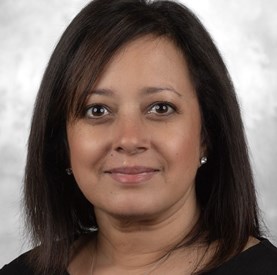Excitement is building as we countdown to RISE West 2024, September 11-13, in Colorado Springs. The event will feature concurrent tracks with sessions that address health plan operations, digital transformation, plan/provider partnerships, keys to compliance, and provider spotlights. In this article, RISE spotlights three speakers from the provider track and what attendees can expect from their sessions.
Reducing provider abrasion through trust, partnership
Sunita E. Varghees, M.D., VP, physician documentation, Baylor Scott & White Health, will serve on a panel that will offer examples of how plans are effectively engaging providers to avoid abrasion.

It hasn’t been easy for providers within her organization. Their patient population has become sicker since COVID-19 as many members neglected to see doctors during the pandemic. And, despite the hope that electronic health records would revolutionize physicians’ workload and make it easier, Dr. Varghees says the technology has made their work more complicated. As a result, providers often don’t have enough time to address patient concerns in a 15-minute or 20-minute block of time.
So, it is a challenge to ask providers to take on something else, such as another tool that may improve documentation. “They already have a bad taste in their mouth from what their experience has been before,” she says.
The key, Dr. Varghees has found, is establishing a relationship of trust by embracing provider pain points and having her team serve as a resource to providers, even finding answers to questions outside their scope of HCCs. “It starts with us asking them, ‘What can we do for you,’ not ‘What do we need you to do.’”
She encouraged her team to take questions about professional billing, hospital billing, or CPT codes and work with other departments to find the answers to physician questions. “It probably took a year of us going into the clinic and saying, ‘what do you need from us, what is your concern,’ with 85 percent of the questions not being CDI questions. Once we established that you ask us the question and we get the answer for you, they were more receptive.”
That relationship, which meant providers saw the coding team as partners, was helpful when the department overhauled its current software tool and had to introduce a new way for doctors to document within the electronic health record. “We worked with the physicians to say this is what’s coming, will this work for you? Some paid attention, some didn’t, and even those that did pay attention still have a list of concerns about the tool. So, we say, let’s work through them one at a time. As long as we acknowledge it is problem and are able to give a realistic timeline of when we think we can solve this issue or provide a logical explanation, they are more receptive.”
The panel, “Focus on Plan/Provider Alignment: Examples in Reducing Provider Abrasion,” will take place 2:25 p.m., Thursday, Sept. 12. In addition to Dr. Varghees, panelists will include Kenneth Persaud, M.D., CEO, White-Wilson Medical Center, P.A.; Kwame Appiah-Yeboah, director, risk adjustment & revenue management, Sentara Health Plans; and Jeremy Cale Browning, MBA, CPC, CRC, director– CDE performance management, Ochsner Health Network. Pareto Intelligence’s Mary Feliz, CRC, manager, risk adjustment consulting, will serve as moderator.
Strategies for addressing social drivers of health
Mital Brahmbhatt, MHA, LMSW, director, health management, Memorial Hermann Health System, will be a member of a Friday panel that focuses on challenges providers face in addressing social determinants of health (SDoH) and how to improve payer/provider partnerships to meet the needs of underserved communities.

Brahmbhatt will discuss her organization’s work from a health system and accountable care organization (ACO) perspective. “We’re an ACO that’s really focusing on population health and addressing those drivers of health that make it challenging for folks to make decisions on their health care, if they are figuring out, do I pay that copay or do I pay for that medication or do I put gas in my car or do I pay for daycare? All of those play a huge factor in the cost curve,” she says.
Two and a half years ago, her department established a community care coordination team that is comprised of members of community health workers, social workers, and a health coach. The team went live in March 2022 and since then has processed approximately 4,000 referrals with a 60 percent success rate. Success for the team means they engaged with the patient, completed an SDoH assessment, followed the patient for at least 21 days, and addressed the patient’s needs, such as making sure the patient got to his or her appointment, or making sure that the team addressed the concerns the patient articulated. “We’ve been able to build a best practice on how do you take a very holistic care coordination perspective and intersperse it with the KPIs that we’re trying to impact,” she says.
The difficult part is that she can’t draw a direct line to the care coordination’s impact on the cost curve because there are so many care team members involved. However, she has seen an increase in patient satisfaction and positive feedback from the organizational stakeholder, such as their payer partners who are appreciative of the uptick in the services offered by her multi-disciplinary team. “That’s probably because my team is addressing all these population health, SDoH challenges that otherwise were going unmet.” As a system, Memorial Hermann has invested in health equity initiatives. Everyone from the C-suite down is committed to making care equitable for everyone, she says. Regardless of payer status, the program, resources, and opportunities should be available to the entire patient population.
“That’s my mission to standardize and normalize that language and that discussion in our system to ensure that we have the right disciplines and the right funding to all be rowing in the same direction,” she says.
The panel, “Spotlight on Providers Addressing Social Drivers of Health,” will be held at 11:10 a.m. Friday, Sept. 13. In addition to Brahmbhatt, panelists include Helen L. Veet, DNP, R.N., director of quality management-PA Medication, AmeriHealth Caritas Pennsylvania, Keystone First, and Jenni Monfils, AVP, risk and quality provider engagement education, Molina Healthcare, Inc. Laura Sheriff, R.N., MSN, CPC, CRC, contracting risk adjustment specialist, will moderate the discussion.
Learnings from a nurse-led AWV program
A case study on Inspira’s nurse-led annual wellness visit (AWV) program will take place on Thursday. Nicole Wright, MSN, R.N., CBN, director of clinical coordination, and Renee Cline, R.N., MSN, CNML, manager of practice coordination, will discuss how the program increased AWV completion rates, decreased provider burden, and how cross-functional collaboration contributed to its success.
During the session, Wright and Cline will talk about what the visit entails.
“It’s not a physical,” says Wright, pictured right. “It’s a comprehensive look at a patient’s wellness. We look at all aspects of the patient holistically. We actually set a care plan, a goal for the patient to achieve before we see them again next year.”

In addition to the health benefit for patients, the visit is a great revenue stream. “The one thing that we can all count on is that we're going to be getting older, we’re all going to matriculate hopefully into Medicare and we're going to have this visit,” she says.
However, with a limited number of providers and limited availability within their schedules, it was difficult for Inspira physicians to fit in all the AWVs as the patient population expanded into Medicare, Wright explains. So, in May 2023, the organization decided to take a team-based approach to the AWV. Nurses take on 90 percent of the visit, allowing the provider to focus on key areas important to the patient. “It’s really us taking a bulk of the visit from the provider and setting the provider up for success,” she says.
The team includes receptionists who are dedicated to outreach and scheduling the AWVs. Medical assistants can help do the intake so, even if a nurse isn’t attached to the visit, by the time a patient sees the provider, a portion of the intake is complete.
The 45-minute nurse-led visit is done virtually, either by laptop, smartphone, an iPad, or telephone call. The follow-up 15-minute provider appointment is face-to-face if necessary. “It really depends on the care-gap closure,” Wright explains. “If the care gaps are open, we need them to go see the provider.”
In 2023, nurses saw over 800 patients. Wright expects they’ll exceed that number in 2024.
Although the program was initially a tough sell to the providers and patients, Wright says they eventually got buy-in from physicians and positive feedback from patients. “Once we had a couple of patient stories, we really marketed that to show how beneficial it was to have these conversations from a nurse,” she says.
Indeed, the program has become so successful, Wright’s role recently expanded to clinical coordination to help support providers with other aspects of care for their patients including clinical triage and other aspects of care coordination.
“The providers really have built such trust and respect for our team that now they want to know what else we can do when they’re organized in a team-based approach to care. The quality for the patient is really going to be impactful,” she says.
Wright and Cline will present their case study at 3:35 p.m. Thursday, Sept. 12.
In addition to the sessions described in this article, the provider track at RISE West will also feature sessions on collaborative compliance and how health care providers and payers can work together to meet reporting goals and improve outcomes. RISE West 2024 will take place September 11-13 at The Broadmoor Resort in Colorado Springs. Click here for the full agenda, roster of speakers, and how to register.
